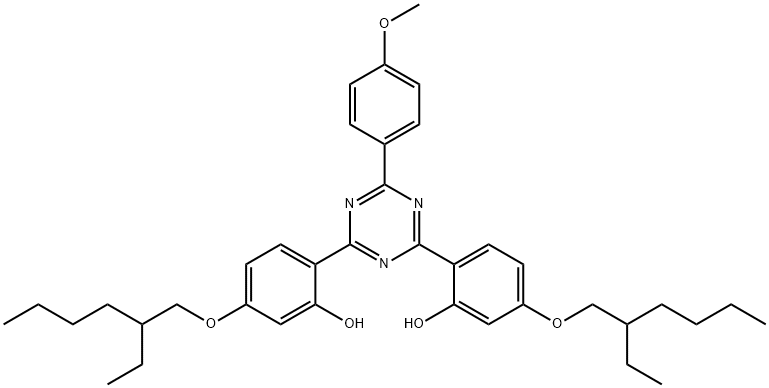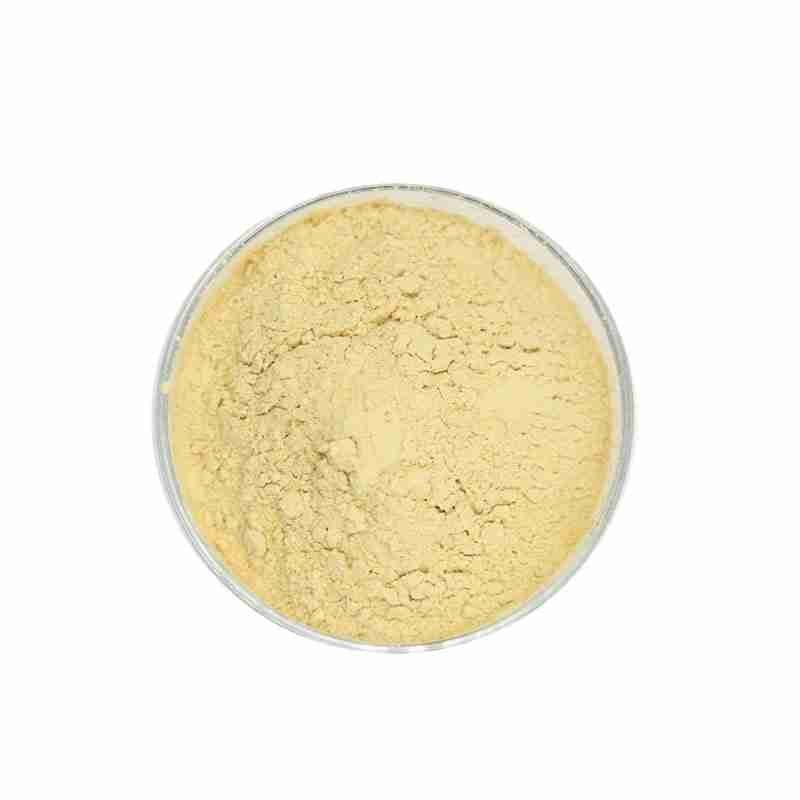Bemotrizinol CAS# 187393-00-6
Bis-ethylhexyloxyphenol methoxyphenyl triazine, also referred to as Bemotrizinol, or BTZ for short, is an oil-soluble organic compound that is included in sunscreen to take in ultraviolet rays. BTZ is a wide-area (broadband) ultraviolet absorb ber. It can soak up UVB and even UVA, and it has 2 absorption optimals, located at wavelengths of 310 as well as 340nm respectively. Its photostability is exceptionally high. Even if 50MEDs (minimum sun direct exposure dose) of ultraviolet light is used, 98.4% of the amount can still be avoided being disintegrated. Combining with various other sunscreens such as avobenzone can likewise inhibit their photodecomposition reaction.
发送询盘
Bemotrizinol CAS# 187393-00-6
| Bemotrizinol Basic information |
| Product Name: | Bemotrizinol |
| Synonyms: | 2,2??-[6-(4-Methoxyphenyl)- 1,3,5-triazine-2,4-diyl] bis{5-[(2-ethylhexyl)oxy]phenol};CGF 1607;FAT 70’884;6,6′-(6-(4-Methoxyphenyl)-1,3,5-triazine-2,4-diyl)bis(3-(2-ethylhexyloxy)phenol);2,4-Bis[4-(2-ethylhexyloxy)-2-hydroxyphenyl]-6-(4-methoxyphenyl)-1,3,5-triazine;(6Z)-3-(2-Ethylhexoxy)-6-[(4Z)-4-[4-(2-ethylhexoxy)-6-oxo-1-cyclohexa-2,4-dienylidene]-6-(4-methoxyphenyl)-1H-1,3,5-triazin-2-ylidene]cyclohexa-2,4-dien-1-one;Phenol, 2,2-6-(4-methoxyphenyl)-1,3,5-triazine-2,4-diylbis5-(2-ethylhexyl)oxy-;BISETHYLHEXYLOXYPHENOLMETHOXYPHENOLTRIAZINE |
| CAS: | 187393-00-6 |
| MF: | C38H49N3O5 |
| MW: | 627.81 |
| EINECS: | 425-950-7 |
| Product Categories: | |
| Mol File: | 187393-00-6.mol |
 |
|
| Bemotrizinol Chemical Properties |
| Melting point | 83-85??; mp 80?? (Mongiat) |
| Boiling point | 782.0??70.0 ??C(Predicted) |
| density | 1.109??0.06 g/cm3(Predicted) |
| storage temp. | Refrigerator |
| solubility | Chloroform (Slightly), Ethyl Acetate (Slightly) |
| pka | 8.08??0.40(Predicted) |
| form | Solid |
| color | Light Yellow to Yellow |
| Odor | Odorless |
| BRN | 11322254 |
| InChIKey | SUKLKCPPDPQLNJ-UHFFFAOYSA-N |
| SMILES | N1=C(C2=CC=C(OC)C=C2)N=C(C2=CC=C(OCC(CC)CCCC)C=C2O)N=C1C1=CC=C(OCC(CC)CCCC)C=C1O |
| LogP | 7.647 (est) |
- 2
- 2-diallylpent-4-en-1-amine
- 4
- 95-16-9
- Ammonium sulfamate
- Benzothiazole
- cas:67889-00-3ح2
- cas:83524-75-8 | pigment black 32
- cas:928836-00-4 | 2
- cas:932745-70-5 | 4
- Chemical Minerals
- Coconut diethanolamide
- Daily Chemicals
- discount
- for sale
- General pvc resin
- hexyl D-glucoside
- in stock
- Lauramidopropyl betaine
- LAURIC ACID MONOETHANOLAMIDE
- Petroleum Additives
- Plasticiser
- Ploymers
- price
- PVC
- quotation
- Raw Materal
- Remove term: Petroleum Additives Petroleum Additive
- SODIUM ETHYL 2-SULFOLAURATE
Related Products
Chemical Name: Ashwagandha Extract
Synonyms: Withania somnifera, ext.; Withania Somnefera Extract
CAS: 90147-43-6
Appearance: Brown
3,4-Ethylenedioxythiophene is a synthetic organic compound characterized by its unique structure that includes a thiophene ring with ethylenedioxy substituents at the 3 and 4 positions. This compound is known for its potential applications in the synthesis of various organic materials, including pharmaceuticals and organic electronic devices such as sensors and solar cells. Its stability and reactivity make it a versatile intermediate in the chemical industry.
Octocrylene is an organic compound widely recognized for its potent UV-filtering properties, making it an essential ingredient in sunscreens and other skincare products designed to protect the skin from harmful ultraviolet radiation. With the chemical name 2-(4-Methylbenzyl)-2H-benzotriazole-5-methyl, octocrylene is a stable and photostable molecule that provides broad-spectrum protection against both UVA and UVB rays.
This oil-soluble chemical is valued for its ability to absorb UV radiation effectively, converting it into heat without causing skin irritation or staining clothes. Octocrylene is often used in combination with other UV filters to enhance the sun protection factor (SPF) of formulations, ensuring a balanced and comprehensive defense against sun damage.
As a lipophilic compound, octocrylene is compatible with various cosmetic and dermatological formulations, contributing to the development of lightweight, non-greasy sunscreens. Its chemical structure allows for a high degree of safety and efficacy, making it suitable for a wide range of skin types, including sensitive skin.
In summary, octocrylene is a reliable and efficient UV filter, pivotal in the formulation of modern sunscreens that offer advanced protection against the sun’s harmful effects while maintaining skin comfort and product aesthetics.
Chemical Name: UV-120
Other Name: (2’,4’-Di-tert-butylphenyl 3,5-di-tert-butyl-4-hydroxybenzoate)
CAS No.: 4221-80-1
Molecular Fomula: C29H42O3
Molecular weight: 438.66
Assay: ≥99%(LC)
Chemical Name: Quercetin-3-O-sophoroside
CAS No.: 18609-17-1
Molecular Formula: C27H30O17
Molecular Weight: 626.52
Product name:HYDROXYPROPYL GUAR HYDROXYPROPYLTRIMONIUM CHLORIDE
Purity:99%
Appearance:Light Yellow Powder
Package:Customized according to customer needs.
Sample:Available
Butylated Hydroxytoluene (BHT) is a synthetic phenolic antioxidant commonly added to foods, cosmetics, and packaging to prevent the oxidation of fats and oils, thereby extending their shelf life. It is also used as a preservative in a variety of products, including rubber, petroleum products, and animal feed. BHT is recognized for its effectiveness in maintaining nutrient levels, color, flavor, and odor in food products . It is known to have a melting point of 69-71??C, a boiling point of 265??C, and is soluble in ethanol, acetone, and benzene, but not in water, glycerin, or propylene glycol . BHT is also used in some dietary supplements due to its antioxidant properties . However, it is important to handle BHT with care, as it can cause skin irritation and is considered harmful if swallowed .
Silicone oil, known for its chemical designation as dimethicone or polydimethylsiloxane, is a synthetic polymer with a backbone of alternating silicon and oxygen atoms, creating a highly versatile and stable compound. It is renowned for its exceptional lubricating properties, heat resistance, and non-toxic nature, making it a staple in various industries, including cosmetics, automotive, and aerospace.
This hydrophobic, non-volatile oil is valued for its ability to provide a smooth, non-greasy feel and to form stable emulsions with other ingredients. In personal care products, silicone oil is used to impart a silky texture, reduce friction on the skin, and create a protective barrier against environmental stressors without clogging pores.
Silicone oil’s chemical inertness and resistance to oxidation contribute to its long shelf life and stability in formulations. It is also appreciated for its compatibility with a wide range of substances, allowing for the creation of multifunctional products.
In summary, silicone oil is a reliable and multifaceted ingredient, offering a combination of performance, safety, and sensory benefits. Its use in a variety of applications reflects its versatility and enduring appeal in the marketplace.
Chemical Name: Dehydrocholic acid
Synonyms: Acide dehydrocholique; Triketocholanic acid
CAS No.: 81-23-2
Molecular Formula: C24H34O5
Molecular Weight: 402.53
Appearance: Powder
Common English name: 5-iodo-2,3-dihydropyridazin-3-one
CAS No.: 825633-94-1
Molecular formula: C4H3IN2O
Molecular weight: 221.98
Sample: Available
Chemical Name: Zinc citrate
Synonyms: Zinc citrate trihydrate
CAS No.: 546-46-3
Molecular Formula: C6H8O7Zn
Molecular Weight: 257.5
Appearance: White powder
Chemical Name: Ammonium Iron(II) Sulfate
Synonyms: Diammonium iron bis(sulphate); iron (ii) ammonium sulfate
CAS No.: 10045-89-3
Molecular Formula: FeH5NO4S
Molecular Weight: 170.95



















